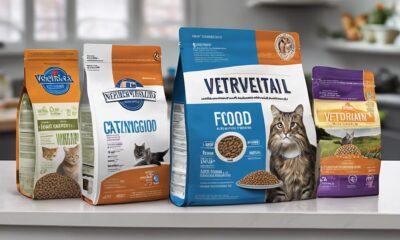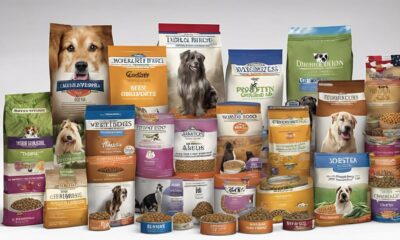Animal Facts
Can Rats Eat Broccoli? Safe Pet Feeding Tips
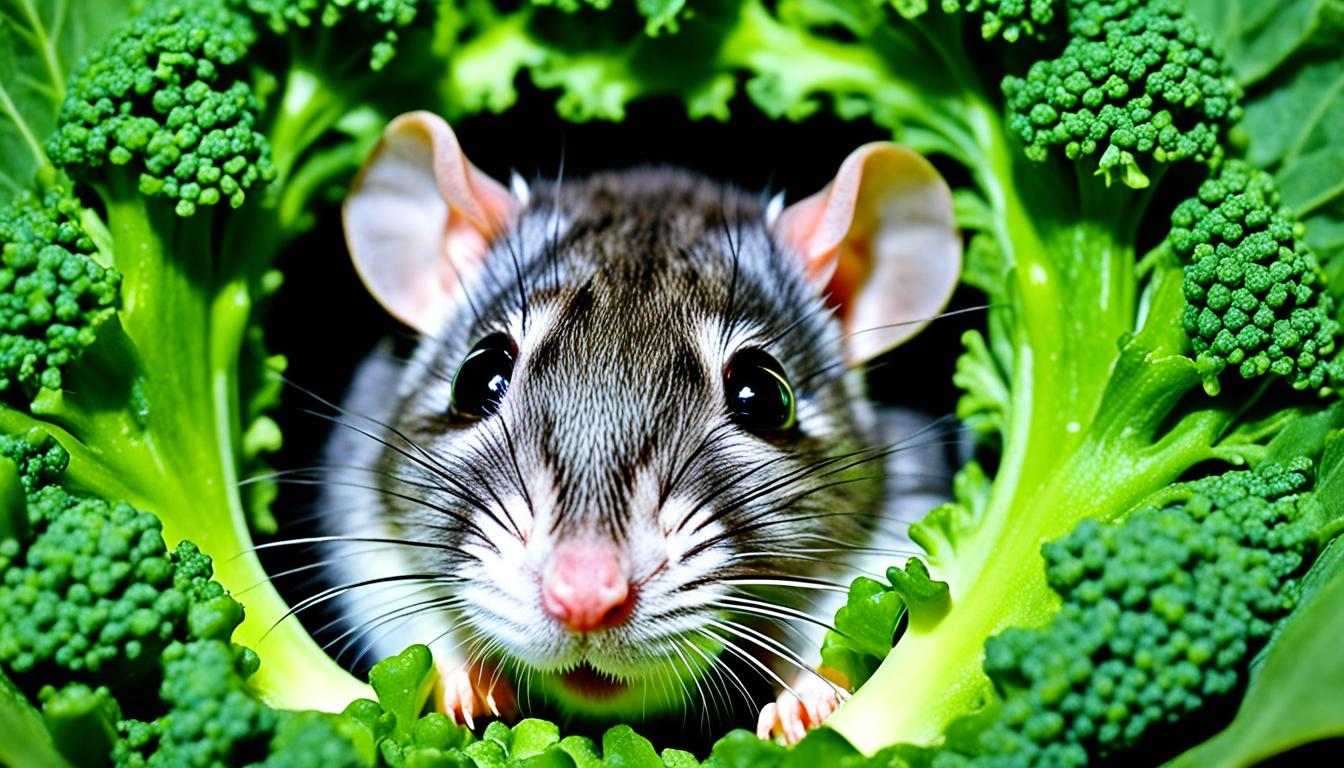
Did you know that rats are opportunistic omnivores and can be selective eaters when it comes to their diet? It’s true! These small and intelligent creatures require proper nutrition to thrive and prevent diseases. If you’re a rat owner or considering adopting a pet rat, you may be wondering if broccoli is safe for them to eat. In this article, we will delve into the topic of rat nutrition and offer you safe pet feeding tips, including whether or not rats can enjoy the benefits of this green vegetable.
Key Takeaways:
- Rats are opportunistic omnivores and can be picky eaters.
- Proper nutrition is crucial for the health of pet rats.
- Broccoli is safe for rats to eat and provides them with essential nutrients.
- Offer a variety of fresh vegetables twice a day, alongside rat pellets, to ensure a balanced diet for your pet rat.
- Avoid certain foods, such as seeds, lactose, chocolate, avocado, and toxic plants, as they can be harmful to rats.
The Importance of Good Eating Habits for Pet Rats
Good eating habits are crucial for the overall health and well-being of our beloved pet rats. Just like humans, rats require a balanced diet to ensure they receive all the necessary nutrients for optimal growth and development.
Unfortunately, many pet rats develop obesity by the age of 12 months, which can lead to various health problems. It’s essential to establish and maintain good eating habits from an early age to prevent these issues.
One common challenge with rats is their selective appetites. While rats are omnivorous, they can develop preferences for certain foods and ignore others. This can lead to an imbalanced diet lacking essential nutrients.
Offering a range of food, particularly vegetables, to juvenile rats can help avoid selective appetites in mature rats. By introducing a variety of flavors and textures early on, we can encourage our rats to develop a more diverse and nutritious diet.
One important aspect of good eating habits for rats is the inclusion of fresh vegetables in their daily meals. We should offer our pet rats a selection of fresh vegetables twice a day, alongside their regular rat pellets. Vegetables not only provide essential vitamins and minerals but also add variety and enrichment to their diet.
It’s important to note that treats should be given sparingly. While rats may enjoy occasional treats, overfeeding with high-fat or sugary foods can contribute to obesity and other health issues.
By maintaining good eating habits, we can help prevent diseases such as heart disease, liver disease, and tumor formation in our pet rats. Proper nutrition plays a vital role in their overall well-being and longevity.
The Benefits of Good Eating Habits for Pet Rats
Here are some of the key benefits of promoting good eating habits in our pet rats:
- Prevention of obesity: By providing a balanced and nutritious diet, we can help our rats maintain a healthy weight and reduce the risk of obesity-related health problems.
- Improved overall health: A well-balanced diet contributes to the overall health and vitality of our pet rats, supporting their immune system and promoting proper organ function.
- Enhanced lifespan: Good eating habits can prolong the lifespan of our pet rats, allowing us to enjoy their companionship for a longer time.
- Reduced risk of dental issues: Gnawing on vegetables and other appropriate chew toys can help keep rats’ teeth healthy and prevent dental problems that may arise from overgrown teeth.
By prioritizing good eating habits and providing a nutritious diet, we can ensure that our pet rats live happy, healthy lives.
Choosing the Right Diet for Your Pet Rat
When it comes to the health of your pet rat, a well-balanced diet is essential. By providing the right nutrients, you can ensure your rat stays happy and healthy. Here are some guidelines to help you choose the right diet for your furry friend:
1. Rat Pellets: A tablespoon of high-quality rat pellets should be offered to your pet rat daily. These pellets are specially formulated to provide the necessary vitamins and minerals your rat needs.
2. Fresh Vegetables: Alongside rat pellets, fresh vegetables should be a staple in your rat’s diet. Aim to offer vegetables twice a day, providing essential nutrients and adding variety to their meals.
3. Treats in Moderation: While treats can be a fun way to bond with your pet rat, it’s important to give them sparingly. Cooked meat, eggs, sugary vegetables, and fruit should be given as occasional treats rather than regular meals.
4. Rat Blocks: To ensure your rat receives all the necessary nutrients, consider offering rat blocks formulated for rodents. These blocks provide a balanced combination of protein, carbohydrates, and fats.
| Food | Recommended Portion |
|---|---|
| Peas | Small portion daily |
| Broccoli | Small portion daily |
| Carrots | Small portion daily |
| Apples | Small portion daily |
| Bananas | Small portion daily |
By following these guidelines, you can ensure that your pet rat receives a well-rounded diet that promotes optimal health and happiness. Remember to always provide fresh water for your rat and consult with a veterinarian for specific dietary recommendations based on your rat’s individual needs.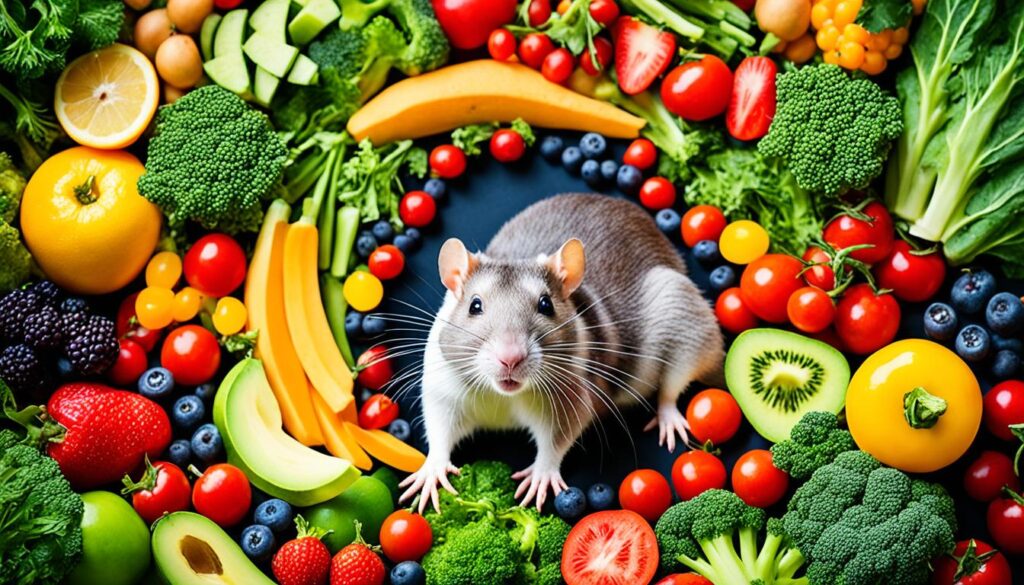
Safe and Unsafe Foods for Rats
When it comes to feeding your pet rat, it’s important to be mindful of what foods are safe and unsafe for them. As responsible rat owners, we want to ensure that our furry friends are getting a balanced and nutritious diet. Here’s a breakdown of safe and unsafe foods for rats:
Safe Foods for Rats
Rats can enjoy a variety of safe foods that are beneficial for their health. These include:
- Asian greens
- Rocket
- Cauliflower
- Kale
- Herbs
- Asparagus
- And more!
These foods provide essential nutrients and add variety to your rat’s diet.
Unsafe Foods for Rats
While rats can enjoy a wide range of foods, there are some things that should be avoided as they can be harmful to their health. The following foods are unsafe for rats:
- Seeds
- Lactose
- Chocolate
- Avocado
- Garlic
- Onion
- Coffee
- Tea
- Alcohol
- Toxic plants
It’s important to keep these foods out of your rat’s reach to prevent any potential health issues.
Providing Fresh Water
Along with offering safe foods, it’s crucial to ensure that your pet rat has access to fresh water at all times. Rats need to stay hydrated, and having clean water available is essential for their overall well-being.
Remember, a well-balanced diet is key to keeping your rat healthy and happy. By providing safe foods and avoiding potentially harmful ones, you can ensure that your pet rat thrives.
| Safe Foods for Rats | Unsafe Foods for Rats |
|---|---|
| Asian greens | Seeds |
| Rocket | Lactose |
| Cauliflower | Chocolate |
| Kale | Avocado |
| Herbs | Garlic |
| Asparagus | Onion |
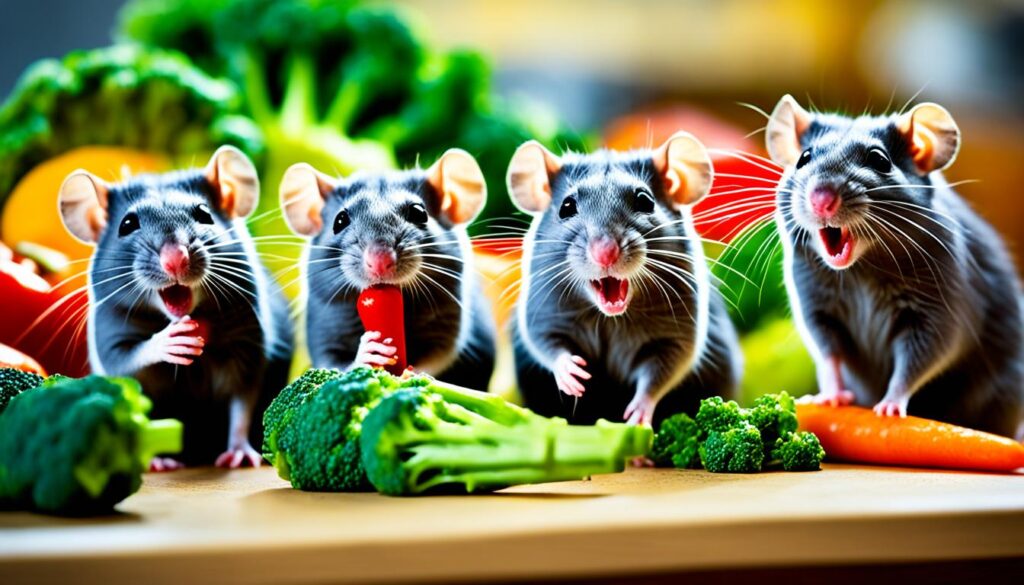
Note: This table provides a summary of safe and unsafe foods for rats. Remember to consult with your veterinarian for personalized dietary advice for your pet rat.
The Importance of Proper Pellet Portion Control
When it comes to feeding pet rats, proper pellet portion control is essential for their health and well-being. Contrary to popular belief, rats should not have free access to pellets at all times. Allowing rats to gorge on pellets can lead to obesity and respiratory diseases, jeopardizing their overall health.
So, how much is too much? Ideally, rats should be offered no more than 1-2 tablespoons of pellets per day, split over two meals. This controlled portion ensures that rats receive adequate nutrition without overindulging. Remember, a balanced and varied diet is crucial for their overall health.
While pellets are an important part of a rat’s diet, they should not be the sole focus. Fresh water should always be available to rats to keep them properly hydrated.
To illustrate the importance of proper pellet portion control, consider the following:
“Proper pellet portion control is crucial in maintaining the health and well-being of pet rats. Many rat owners unknowingly overfeed their furry friends, leading to preventable health issues. By monitoring and controlling the amount of pellets given to rats, we can help them maintain a healthy weight and minimize the risk of respiratory diseases.”
The Dangers of Overfeeding
Overfeeding rats with pellets can have serious consequences. The excess calories can quickly lead to weight gain and obesity, which increases the risk of various health problems, including:
- Heart disease
- Diabetes
- Liver disease
- Tumor formation
By practicing proper pellet portion control, we can help prevent these health issues and ensure that our pet rats maintain a healthy weight throughout their lives.
Remember, a balanced diet that includes a variety of foods, such as fresh vegetables, is crucial for the overall well-being of your pet rat.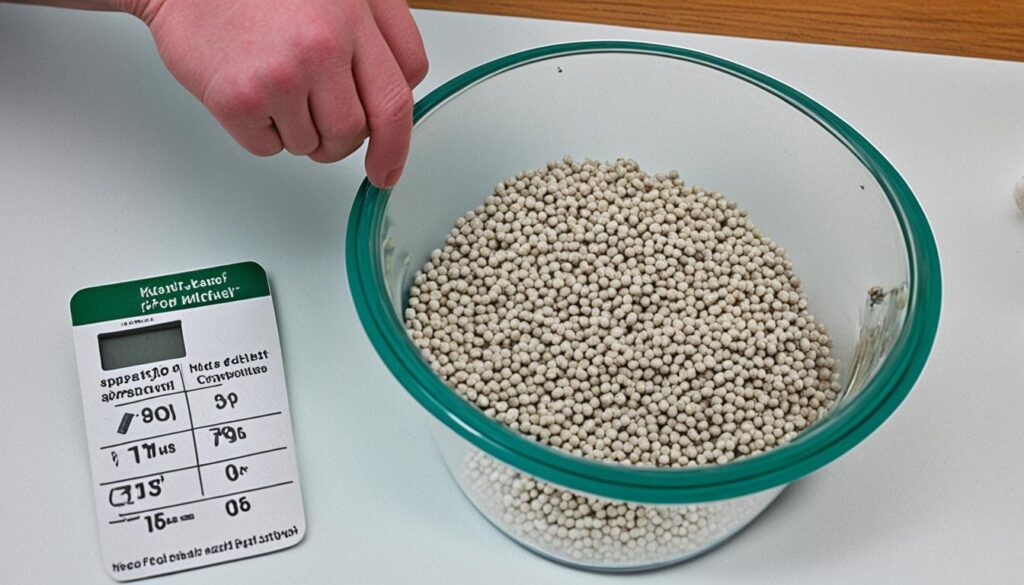
By being mindful of the amount of pellets we offer our pet rats and providing them with a varied diet, we can help them live a long and healthy life.
Providing a Healthy Habitat for Your Pet Rat
When it comes to providing a healthy habitat for your pet rat, there are several important factors to consider. Rats thrive in cages with wire walls and a solid bottom, providing them with both ventilation and stability. A minimum cage size of 2’x2’x2′ is recommended for a pair of rats, allowing them enough space to move around and play.
It’s crucial to choose the right bedding for your rat’s cage. Aspen shavings or recycled paper pellets are excellent choices as they are absorbent and safe for your pet. Make sure to line the cage with a thick layer of bedding to provide comfort and warmth for your rats.
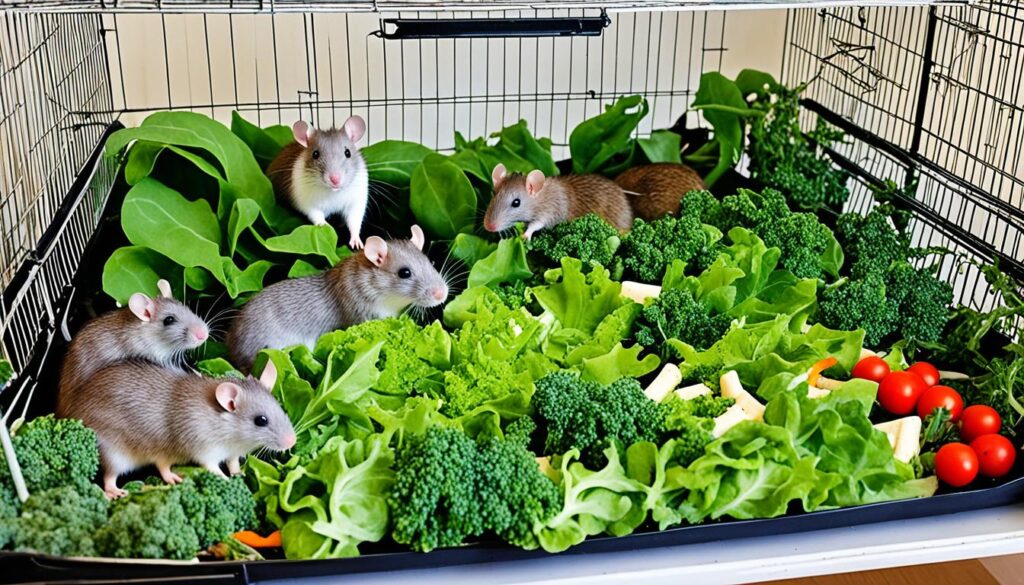
Creating hiding places in the cage is essential to promote your rat’s natural behaviors. Small boxes or flower pots placed strategically in the cage can serve as cozy hiding spots where your rats can relax and feel safe.
Rats are active creatures that enjoy running, climbing, and exploring. Consider providing tunnels and tree branches for them to play with in their habitat. These additions not only offer physical exercise but also mental stimulation, keeping your rats entertained and happy.
Another important aspect of a healthy rat habitat is the availability of toys. Solid exercise wheels are an excellent addition to your rat’s cage, as they provide an outlet for energy and promote physical health. Interactive toys such as puzzle feeders or chew toys can also engage your rats mentally, preventing boredom and encouraging natural behaviors.
Remember, a healthy habitat plays a crucial role in the overall well-being of your pet rat. By providing the right environment filled with comfort, stimulation, and opportunities for exercise, you can ensure a happy and thriving rat companion.
Maintaining a Clean and Tidy Cage
Keeping your pet rat’s cage clean and tidy is essential for their health and well-being. A clean environment helps prevent the spread of bacteria and ensures that your rat feels comfortable and safe in their living space.
Daily tidying of the cage is important to maintain cleanliness. Remove any droppings, old food, and soiled bedding on a daily basis. This helps to control odors and keeps the cage fresh for your pet.
“A clean cage promotes a healthy and happy rat.”
Once a week, it’s necessary to give the cage a thorough scrubbing. Start by removing all rats, toys, and accessories from the cage. Using warm soapy water, thoroughly clean all surfaces of the cage. This includes the walls, floor, ramps, and platforms. Rinse the cage well to remove any soap residue, and dry it completely before reintroducing your rats.
When replacing the bedding in the cage, choose a clean and absorbent material for your rat’s comfort. Aspen shavings or recycled paper pellets are commonly used and provide a cozy nest for your rats.
To summarize, a clean and tidy cage is essential for maintaining your pet rat’s health and happiness. By tidying up daily, removing waste and soiled bedding, and giving the cage a weekly scrub, you can provide a clean and safe environment for your furry friend.
| Benefits of a Clean Cage | Tips for Maintaining a Tidy Cage |
|---|---|
| 1. Prevents the spread of bacteria and disease | 1. Remove droppings, old food, and soiled bedding daily |
| 2. Controls odors and keeps the cage fresh | 2. Thoroughly clean the cage with warm soapy water once a week |
| 3. Promotes a healthier living environment for your rat | 3. Choose clean and absorbent bedding material |
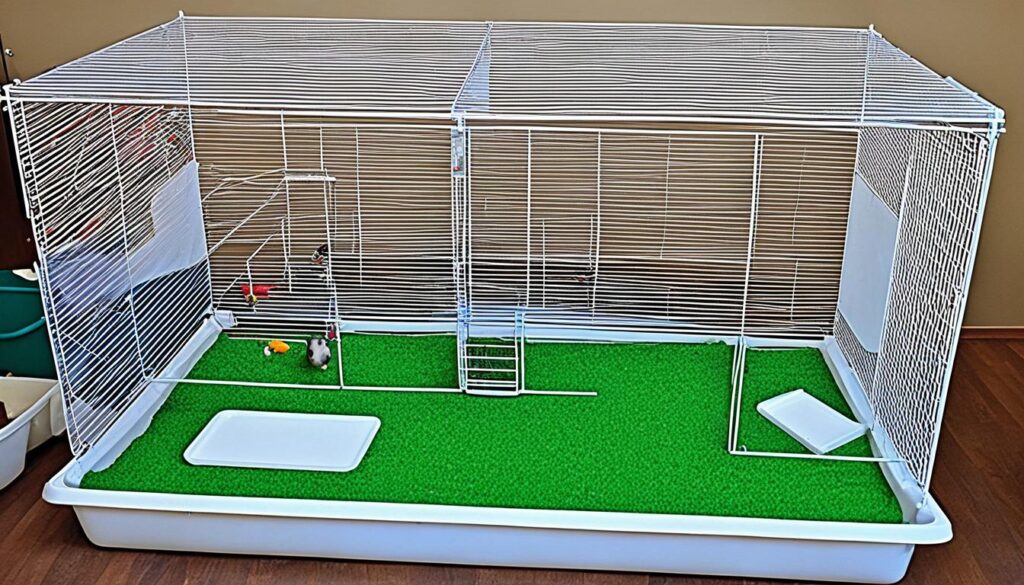
Providing a clean and tidy cage for your pet rat shows that you care about their well-being. By following these tips, you can ensure a clean and safe living environment for your furry friend.
The Importance of Dental Care for Rats
Rats’ teeth never stop growing, which means they have a constant need to gnaw on things to keep their teeth in good health. Dental care is crucial for rats to prevent overgrown teeth and other dental issues that can cause pain and discomfort.

To provide dental care for your pet rat, there are a few simple steps you can follow:
- Offer untreated, unpainted pieces of wood: Rats love to chew on wooden objects, and providing them with safe and appropriate wood pieces can help wear down their teeth. Make sure the wood is free from any chemicals or paints that can harm your rat.
- Give fruit tree branches: Fruit tree branches are another great option for rats to gnaw on. Apple, pear, and cherry tree branches are safe choices that can help keep their teeth in good condition. Just make sure the branches are pesticide-free.
- Consider dog biscuits: Some dog biscuits are hard and crunchy, which makes them suitable for rats to chew on. Look for biscuits that are low in sugar and free from any harmful additives.
By providing rats with these dental care options, you can help promote good oral health and prevent dental problems. Remember to monitor your rat’s chewing habits and ensure they have access to appropriate items to keep their teeth healthy.
Promoting Physical Activity and Mental Stimulation
Pet rats are very intelligent and social animals that require regular physical activity and mental stimulation. To ensure the well-being of your furry friend, it is important to provide opportunities for exercise and enrichment.
One way to promote physical activity in rats is to let them out of their cages for supervised playtime. Aim for at least an hour of playtime each day, allowing your rat to explore and stretch its legs. Create a safe and rat-proofed environment where your pet can roam freely under your watchful eye.
| Physical Activities for Rats | Description |
|---|---|
| Running | Provide an exercise wheel or a large, safe space for your rat to run around. |
| Climbing | Set up ladders, tunnels, and platforms to encourage your rat to climb and explore vertical spaces. |
| Playing with Toys | Offer a variety of toys such as chew toys, puzzle toys, and interactive toys to keep your rat mentally engaged. |
Along with physical activity, mental stimulation is essential for the overall well-being of your pet rat. Rats are intelligent creatures that thrive on mental challenges.
“Mental stimulation is vital for rats as it helps to keep their minds sharp and prevents boredom,” says Dr. Emily Rodriguez, a veterinarian specializing in small mammals.
Interactive toys, such as puzzle feeders, can provide mental stimulation for rats. These toys require problem-solving skills, encouraging your rat to think and strategize to obtain its food or treats. Additionally, rotating toys and introducing new objects into their environment can help prevent monotony and keep your rat engaged.
Remember, a happy and healthy rat is one that receives both physical activity and mental stimulation. By incorporating these activities into your rat’s daily routine, you can ensure that they live a fulfilling and enriched life.
Conclusion
In conclusion, rats can safely enjoy broccoli as part of a balanced diet. As pet owners, we should strive to offer our furry friends a variety of foods that promote good eating habits. This includes providing fresh vegetables, such as broccoli, alongside their regular rat pellets. By offering a diverse range of nutritious foods, we can ensure that rats get the essential nutrients they need to maintain their health and well-being.
Proper nutrition plays a vital role in preventing diseases in rats. A well-balanced diet can help ward off conditions like obesity, heart disease, liver disease, and tumor formation. It is crucial to prioritize their dietary needs to ensure their long-term health.
In addition to a healthy diet, creating a clean and stimulating environment is essential for the overall well-being of pet rats. Regular cage cleaning, providing them with toys and hiding spots, and allowing for supervised playtime outside the cage are all important aspects of maintaining their mental and physical health.
Remember, dental care and physical activity are also vital for the happiness of rats. Providing appropriate items for them to chew on helps keep their teeth in check. Additionally, engaging them in regular exercise and providing mental stimulation through toys and interactive playtime are crucial for their overall well-being.FAQ
Can rats eat broccoli?
Why is good eating habits important for pet rats?
What is the right diet for a pet rat?
What are some safe and unsafe foods for rats?
Why is proper pellet portion control important for rats?
How do I provide a healthy habitat for my pet rat?
How do I maintain a clean and tidy cage for my rat?
Why is dental care important for rats?
How can I promote physical activity and mental stimulation for my rat?
Can rats eat broccoli as part of a balanced diet?
As our Editor-in-Chief, James plays a pivotal role in ensuring the quality and integrity of our content. With a keen eye for detail and a passion for storytelling, James oversees the editorial process here at A Place for Animals. With years of experience in content editing, James ensures that every piece of content meets our high standards of accuracy and clarity. Under James’ guidance, you can rest assured that the content you read is informative and impeccably crafted.
Animal Facts
The Fascinating World of Hedgehog Personalities
Learn about the captivating traits of hedgehog personalities and uncover the secrets behind their intriguing social behaviors and unique interactions. What else might surprise you?

Hedgehog personalities are truly fascinating, shaped by their unique social behaviors and environmental influences. You'll notice that these primarily solitary creatures engage in limited interactions, except during mating season when males court females through scent marking. Their foraging habits reflect a keen adaptability, as they navigate various habitats in search of food. While aggression is rare, it tends to occur over territory or mating rights. Understanding how these factors interplay reveals much about their behaviors. Curious about what else contributes to their intriguing personalities? There's so much more awaiting discovery in the wild world of hedgehogs.
Key Takeaways
- Hedgehogs are primarily solitary animals, exhibiting unique personalities that manifest mostly during mating season and territorial behaviors.
- Individual hedgehogs display distinct foraging techniques, influenced by their adaptability to varying environments and food availability.
- Non-verbal communication through scent and body language plays a significant role in hedgehog interactions, revealing their personalities and social dynamics.
- Play behavior, although less common, can indicate social adaptability, showcasing individual hedgehogs' willingness to engage in interactions.
- Variations in aggression levels, primarily related to territory and mating, highlight personality differences among hedgehogs in competitive contexts.
Understanding Hedgehog Personalities
Hedgehog personalities are fascinating reflections of their solitary nature and unique social behaviors. You'll notice that these creatures know one big thing: they thrive in solitude. Unlike many other animals, hedgehogs primarily interact with one another during mating season, showcasing a social system with limited interactions.
Their foraging behavior is characterized by heightened alertness; they often pause to sniff the air, carefully avoiding encounters with other hedgehogs through mutual avoidance strategies. Maintaining a balanced diet and regular physical activity, akin to the principles of holistic lifestyle approach, can help enhance their well-being in the wild.
Interestingly, aggressive encounters among hedgehogs are rare. Observations reveal that only about 0.06% of interactions lead to fights, underscoring their generally peaceful demeanor.
When the mating season arrives, you'll see a shift in behavior, as males engage in courtship rituals like circling and scent marking. They rely heavily on scent to identify potential mates and rivals, which highlights their keen olfactory senses.
Environmental factors, such as habitat fragmentation and urban settings, play a significant role in shaping hedgehog behavior. Understanding these personalities helps you appreciate the delicate balance hedgehogs maintain in their solitary lives, emphasizing the need for conservation efforts to support their populations.
Social Behavior and Interactions

While primarily solitary, hedgehogs exhibit captivating social behaviors, especially during mating season. During this time, you might notice an increase in encounters between these small creatures.
Hedgehogs typically practice a mutual avoidance strategy, which results in only 0.7% of their non-sexual interactions leading to fights. This tactic helps them reduce aggressive encounters, allowing for a more peaceful existence.
Curiously, similar to how investors evaluate their options in gold and silver investments, hedgehogs assess their social interactions to maintain harmony in their environment.
When mating season arrives, courtship behaviors come to the forefront. You may observe males and females engaging in activities like circling and scent marking, which are essential for communication.
Hedgehogs rely heavily on scent cues to identify each other's presence, influencing their social behavior and interactions.
During nesting season, social dynamics shift. Females tend to avoid one another to minimize competition for resources, while males may exhibit aggressive behavior over territory and mating rights.
This nuanced social behavior reflects the complexity of hedgehog personalities, showcasing their ability to adapt their interactions based on circumstances.
Understanding these social behaviors gives you greater insight into the fascinating world of hedgehogs and their unique ways of maneuvering relationships.
Foraging Habits and Preferences

When you observe hedgehogs foraging, you'll notice their keen alertness as they sniff the air for food and potential threats.
Their preferred diet mainly includes invertebrates, reflecting their role as effective predators in the wild. This diet aligns with the principles of foraging basics, emphasizing the importance of identifying edible foods in their environment.
You'll also see how their foraging habits change based on the environment, including factors like supplemental feeding that can influence their natural instincts.
Foraging Techniques Overview
Foraging techniques in hedgehogs reveal a fascinating blend of alertness and adaptability, as these creatures navigate various environments in search of food. You'll notice how they exhibit keen foraging behavior, often pausing to sniff the air. This helps them detect food while also being aware of potential predators. Active primarily at night, hedgehogs hunt for invertebrates, employing their strong sense of smell to locate meals.
Here's a quick overview of their foraging techniques:
| Foraging Technique | Description | Environment Adaptability |
|---|---|---|
| Alertness | Frequently pauses to listen and sniff | Effective in various habitats |
| Night Activity | Hunts primarily at night | Urban, gardens, woodlands |
| Scent Tracking | Relies on smell to find food | Navigates complex terrains |
| Solitary Behavior | Rarely encounters other hedgehogs | Avoids competition |
| Adaptable Diet | Consumes diverse invertebrates | Flexible based on availability |
Understanding these foraging techniques can help you appreciate the hedgehog's unique approach to survival in different environments. Their ability to adapt while foraging highlights their resilience in the wild.
Preferred Food Sources
Hedgehogs have a diverse palate, primarily foraging for invertebrates like worms, slugs, and beetles, which form the backbone of their diet. This carnivorous little creature knows one big secret: a varied diet is key to its health.
While invertebrates are their mainstay, they occasionally indulge in small vertebrates like frogs or baby birds, and even fruit when the mood strikes. Understanding the importance of nutrition for other animals, such as dogs, can help us appreciate the dietary needs of hedgehogs as well, especially when considering dog health and nutrition.
When considering what to feed a hedgehog, keep these preferences in mind:
- Invertebrates: Worms, slugs, and beetles are essential.
- Occasional treats: Small vertebrates can be a fun addition.
- Avoid dairy: Hedgehogs are lactose intolerant, so skip the milk.
Their excellent sense of smell aids them in locating these food sources, especially during their nocturnal foraging. You'll find them active at night, hunting effectively while dodging the heat of the day.
For the best nutrition, opt for wet cat food or specialized hedgehog food. By understanding their preferred food sources, you can guarantee your hedgehog thrives and enjoys a healthy, balanced diet.
Impact of Environment
The environment plays a essential role in shaping hedgehogs' foraging habits and preferences. As you observe these fascinating creatures, you'll notice how alert they are while foraging, often pausing to sniff the air. This behavior helps them locate food and avoid encounters with other hedgehogs, critical for their solitary lifestyle.
Habitat fragmentation can greatly impact their success in finding food. In fragmented areas, the availability of prey like worms, slugs, and beetles varies. Here's a glimpse at how different environments can affect hedgehog foraging:
| Environment Type | Impact on Foraging |
|---|---|
| Urban Areas | Increased human activity alters foraging patterns; food sources may be less reliable. |
| Rural Areas | Rich in natural prey; hedgehogs can forage effectively. |
| Fragmented Habitats | Limited food availability; hedgehogs may struggle to find sufficient prey. |
| Dense Forests | Abundant hiding spots; enhanced foraging opportunities due to diverse food sources. |
Through scent cues, hedgehogs enhance their survival strategy. Their solitary nature and the challenges posed by the environment make foraging both a necessity and a fascinating aspect of hedgehog life.
Aggression and Conflict Dynamics

In the world of hedgehog behavior, aggression and conflict dynamics are surprisingly subtle. While you might expect frequent confrontations, aggressive encounters among hedgehogs are quite rare, making up only about 0.06% of all observed interactions in urban settings like London.
When male hedgehogs do display aggression, it's usually over territory or mating rights, yet these confrontations tend to be more about posturing than actual violence. Curiously, similar to the dynamics observed in narcissistic relationships, hedgehogs also prioritize their self-image and social standing, leading to non-confrontational behaviors that help maintain their social structure recognizing dangerous narcissistic behaviors.
Here are three key points to reflect upon regarding hedgehog aggression:
- Scent Communication: Hedgehogs rely heavily on scent to identify each other, which helps determine whether to engage or avoid a confrontation.
- Silent Interactions: During close encounters, hedgehogs often engage in non-verbal cues that indicate their intentions without escalating to aggression.
- Mutual Avoidance: This strategy allows hedgehogs to coexist in overlapping home ranges, considerably reducing the chances of conflict.
Understanding these dynamics sheds light on how hedgehogs navigate their social environment while minimizing aggression, showcasing their fascinating adaptability.
Reproductive Patterns and Courtship
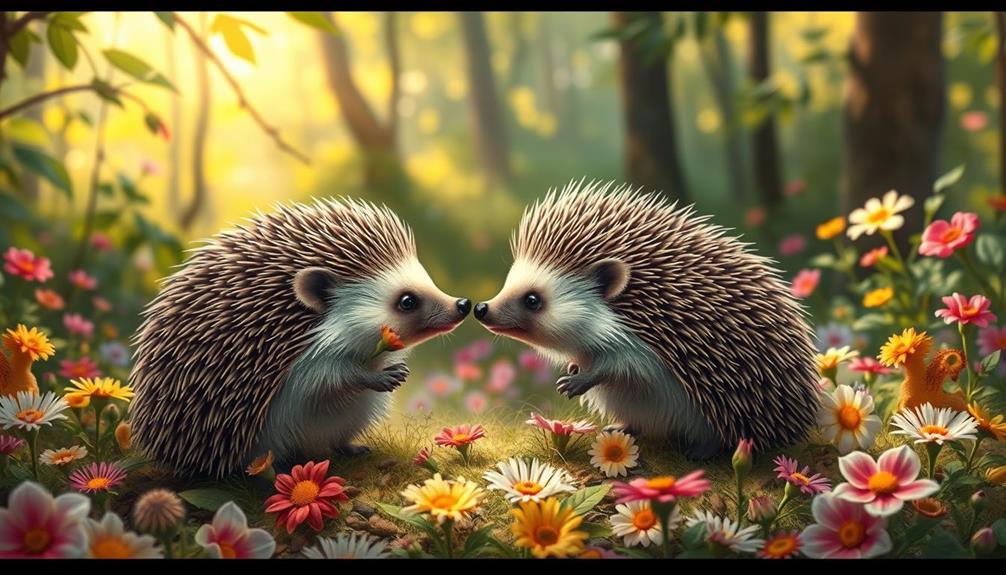
Maneuvering their social environment is just one aspect of hedgehog life; when it comes to reproduction, a different set of behaviors comes into play. During mating season, which peaks from May to July, male hedgehogs engage in various courtship behaviors to attract females. They often circle around potential mates and rely heavily on scent marking to communicate their presence and readiness.
Notably, studies have shown that astrology and attractiveness can influence animal behavior, reflecting the complexities of attraction even in the animal kingdom. As a female hedgehog, you'll notice that other females tend to keep their distance during nesting season. This behavior helps reduce competition for both resources and mates.
Male hedgehogs, on the other hand, face intense competition for mating rights. They may display aggressive behaviors, such as pushing or vocalizations, to establish dominance over rivals. Scent plays a vital role in this courtship process, as males use olfactory cues to identify receptive females and gauge the presence of competing males nearby.
All these behaviors are essential for successful reproduction, ensuring that the strongest and most appealing males get the chance to mate. Understanding these courtship dynamics can give you a deeper appreciation for the fascinating world of hedgehog personalities during this critical time in their lives.
Environmental Influences on Behavior

When you think about hedgehogs, consider how their ability to adapt to different habitats shapes their behavior.
For instance, urbanization can greatly impact their movement and foraging habits, forcing them to navigate through fragmented landscapes. In regions like New England, where diverse landscapes include mountains and forests, hedgehogs may thrive in more natural settings, while facing challenges in urban areas that lack proper camping amenities and facilities.
Understanding these environmental influences helps you appreciate the resilience and challenges hedgehogs face in their daily lives.
Habitat Adaptation Strategies
Adapting to various habitats, hedgehogs showcase remarkable strategies influenced by their surroundings.
These adorable creatures thrive in diverse environments, from urban areas to woodlands and gardens. Their habitat adaptation strategies are vital for survival, as they respond to the availability of food and shelter.
Play behavior in animals, similar to how children engage in the importance and benefits of play, can also influence their adaptability and social interactions.
Here are three key strategies you might find fascinating:
- Foraging Behavior: Hedgehogs adjust their foraging techniques based on food sources available in their environment. Urban gardens often provide supplemental feeding opportunities that can change their natural hunting patterns.
- Nesting Choices: In fragmented habitats, hedgehogs may seek out hidden spots for nesting, ensuring safety from predators and harsh weather. They often rely on dense vegetation and hedgerows, which offer vital cover.
- Movement Patterns: As habitat fragmentation increases, hedgehogs adapt their movement strategies to navigate between foraging areas and nesting sites. This flexibility is significant for maintaining their populations in changing environments.
Urbanization Effects on Behavior
Urban environments present a mixed bag for hedgehogs, profoundly influencing their behavior and survival. While urbanization fragments their habitats, it also pushes hedgehogs to adapt in remarkable ways. You might spot them foraging in gardens, parks, and even cemeteries, which offer essential resources.
In these urban spaces, the presence of air purifiers can contribute to cleaner air, indirectly supporting the health of wildlife, including hedgehogs. However, these areas come with dangers like road traffic that can threaten their safety.
In cities, supplemental feeding often alters hedgehogs' natural foraging patterns. You may find them becoming reliant on human-provided food, potentially compromising their instinctual behaviors. The presence of humans and domestic pets can create stress, leading to reduced nocturnal activity—an essential aspect of their survival.
Conservation efforts aim to mitigate these challenges by creating hedgehog-friendly environments. You might see initiatives focused on enhancing habitat connectivity and minimizing mortality risks from human activities.
Frequently Asked Questions
What Is a Hedgehog's Personality Like?
A hedgehog's personality is independent and cautious. They're observant, relying on their keen sense of smell to navigate their environment. While mostly solitary, they become more social during mating season, engaging in courtship behaviors.
What Are the Characteristics of a Hedgehog?
Hedgehogs are spiny, nocturnal creatures, known for their curious habits, strong sense of smell, and unique diet. With a knack for foraging and a resistance to venom, they're truly fascinating little animals you'll appreciate.
How Does the Hedgehog Mentality Differentiate From the Fox Mentality?
The hedgehog mentality focuses on deep expertise in one area, while the fox mentality embraces adaptability across various domains. You'll find hedgehogs assertive and direct, whereas foxes excel in collaboration and nuanced interactions.
What Are 5 Interesting Facts About Hedgehogs?
You'll find hedgehogs fascinating! They're nocturnal, hibernate in winter, possess 5,000 to 7,000 protective spines, rely on keen senses for foraging, and can run up to 4 miles per hour in search of food.
Conclusion
In exploring the fascinating world of hedgehog personalities, you've discovered that these creatures are more complex than they seem. Did you know that nearly 80% of hedgehogs exhibit distinct social behaviors when interacting with their peers? This statistic highlights how their personalities shape their daily lives and relationships. By understanding their unique traits, you can appreciate the rich tapestry of hedgehog behavior and the environmental factors that influence them. Embrace the quirks of your prickly friends!
Dana is our Lead Content Writer, bringing a wealth of knowledge and expertise to our team. With a background deeply rooted in animal studies and a profound love for all creatures, Dana is dedicated to crafting engaging and informative content that resonates with our audience. With Dana at the helm, you can trust that our content is accurate and engaging, catering to the diverse interests of animal enthusiasts everywhere.
Animal Facts
Cat Breeds Popular in Pennsylvania: A Comprehensive Guide
Unearth the most beloved cat breeds in Pennsylvania and discover which one might be the perfect companion for you. Are you ready to find your feline friend?

If you're curious about popular cat breeds in Pennsylvania, you're in for a treat! The Domestic Shorthair is a favorite for its friendly nature and adaptability. The Maine Coon, known as a gentle giant, is great for families, while the affectionate Ragdoll captures hearts with its striking blue eyes. You might also enjoy the social Siamese, famous for their chatter. Finally, the robust Siberian is perfect for colder climates. Each breed has unique traits and care needs that fit various lifestyles. Stick around, and you'll discover valuable insights into adoption resources and tips for new cat owners.
Key Takeaways
- Domestic Shorthairs are the most popular breed in Pennsylvania, known for their adaptability and friendly nature.
- Maine Coons are favored for their large size and sociable disposition, making them great for families.
- Ragdolls are highly sought after due to their affectionate demeanor and striking blue eyes.
- Siamese cats are appreciated for their vocal personalities and interactive behavior with owners.
- Local shelters in Pennsylvania offer various adoption resources and events for prospective cat owners.
Overview of Popular Cat Breeds
Exploring the world of feline companions, you'll find that several cat breeds stand out in Pennsylvania. One of the most common is the Domestic Shorthair, known for its mixed heritage and effective hunting abilities. It's a medium-sized cat that typically lives around 12-14 years.
Close behind is the American Shorthair, originally bred for rodent control, which is recognized for its sociable nature and muscular build, making it a family favorite. Additionally, many families are increasingly drawn to tough dog names when considering pets, showcasing a trend in selecting strong character traits for their companions.
If you're drawn to unique looks, consider Siamese cats. With their striking blue eyes and vocal personalities, they're favored for their intelligence and social behavior.
The Maine Coon, another beloved breed in Pennsylvania, is notable for its large size and friendly disposition, often adapting well to various living situations.
Ultimately, Siberian cats are gaining popularity thanks to their thick, triple-layered coats, perfect for colder climates. Known for their affectionate nature and robust health, they make excellent companions.
Each of these breeds brings something special to the table, whether it's a playful spirit or a loving demeanor, making them all cherished choices for cat lovers in Pennsylvania.
Characteristics of Pennsylvania Cats

Cats in Pennsylvania exhibit a range of distinctive characteristics that make them appealing companions. Each breed brings unique traits that cater to different lifestyles and preferences. For instance, the Domestic Shorthair is a common sight, known for its mixed heritage and effective rodent control abilities.
The table below summarizes some popular breeds and their key characteristics:
| Cat Breed | Key Characteristics | Ideal For |
|---|---|---|
| American Shorthair | Sociable, muscular, family-friendly | Households with kids |
| Maine Coons | Large size, friendly demeanor | Families wanting gentle giants |
| Ragdolls | Affectionate, striking blue eyes | People seeking companionship |
| Siberian breed | Thick, water-resistant coat | Owners in varied climates |
Maine Coons are especially notable for their gentle giant reputation, while Ragdolls charm with their affectionate nature. The American Shorthair is favored for its sociability. Finally, the Siberian breed's adaptability makes it a loyal choice for many. Whether you seek playfulness or companionship, Pennsylvania's cats offer a perfect fit for every lifestyle.
Care Requirements for Each Breed

When it comes to caring for different cat breeds, each has its own unique requirements that can greatly impact your experience as an owner. Understanding the grooming needs and temperament of these popular breeds in Pennsylvania will help you provide the best care.
Additionally, it's important to take into account any specific health needs or potential grooming costs associated with each breed, similar to how rebonding costs can vary by treatment.
- Ragdoll cats: These affectionate companions have soft, semi-longhair coats that require minimal grooming, making them ideal for families.
- Maine Coons: With their rugged, water-resistant fur, regular grooming is essential to prevent matting. Their friendly nature makes them sociable pets.
- Persian cats: Their long, luxurious fur necessitates daily grooming to avoid mats and tangles. They thrive in calm environments, reflecting their gentle demeanor.
On the other hand, Siamese cats have short coats that require minimal grooming, but they need regular play and companionship to stay happy.
Similarly, Siberian cats possess thick, water-resistant fur that demands regular grooming, and their playful nature makes them an excellent choice for families with children.
Adoption and Rescue Resources
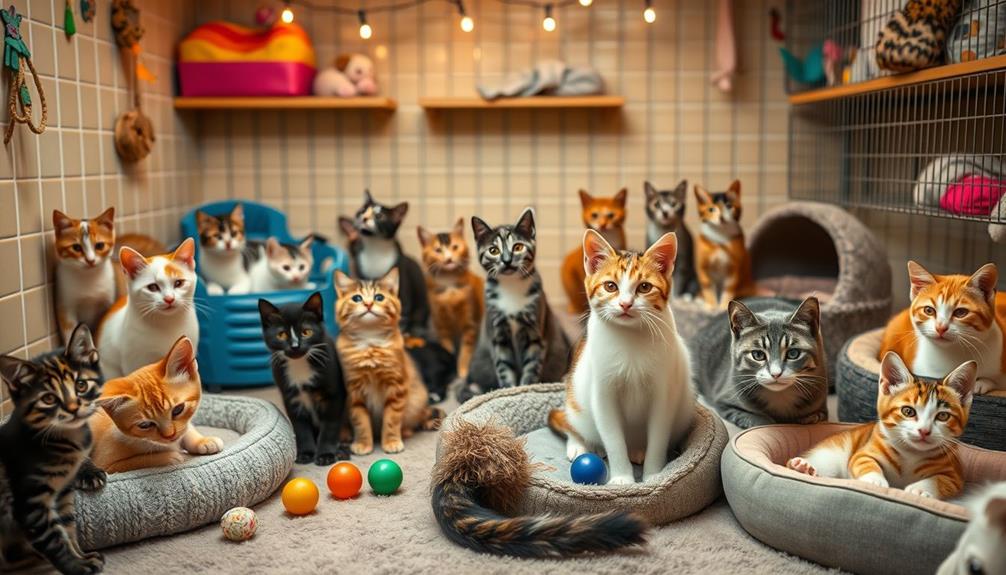
If you're looking to adopt a cat in Pennsylvania, you're in luck—there are plenty of local shelters and organizations ready to help. Many of these groups host adoption events where you can meet cats in need of homes and even take advantage of special fee promotions.
Additionally, fostering pets can be a rewarding experience that supports the community and helps animals find their forever homes.resources available from organizations like the James L. West Alzheimer Center highlight the significance of support networks for all kinds of care.
Plus, if you're interested in making a difference, there are numerous volunteer opportunities available to support these essential resources.
Local Shelters and Organizations
Pennsylvania boasts a vibrant network of local shelters and rescue organizations dedicated to finding loving homes for cats in need.
These organizations play an essential role in promoting responsible pet ownership and providing care for abandoned and stray cats. With the increasing necessity of home security systems, many cat owners are now considering ways to guarantee their homes are safe for their furry friends, which can also enhance their adoption experiences through added peace of mind.
Here are three key players in the community:
- Pennsylvania SPCA – This well-known organization offers a variety of services, including low-cost adoption events that often include vaccinations and spaying or neutering.
- Animal Rescue League of Western Pennsylvania – They focus on rescuing and rehabilitating cats, assuring they receive the care they need until they find forever homes.
- Cat Welfare Association and Feline Rescue Association – Both organizations specialize in fostering stray and abandoned cats while implementing TNR (Trap-Neuter-Return) programs to manage feral populations effectively.
The average adoption fee for cats in Pennsylvania ranges from $50 to $150, depending on the shelter and the cat's age and health status.
By supporting these local shelters and participating in their adoption events, you contribute to the welfare of cats in your community and help reduce the number of homeless pets.
Additionally, consider adding some humor to your home with funny ring doorbell names that can reflect your personality while welcoming visitors.
Adoption Events and Fairs
Bringing together cat lovers and potential adopters, adoption events and fairs in Pennsylvania create vibrant spaces where you can meet your future feline companion. Throughout the year, local shelters and rescue organizations host these exciting events, featuring a variety of cat breeds, including the beloved Ragdolls. Here, you'll have the chance to find the perfect match for your family.
These gatherings also serve as a reminder of the significance of community support in fostering healthy relationships, much like the dynamics found in narcissistic abuse impacts.
Adoption fairs often provide valuable educational resources about responsible pet ownership and cat care, guaranteeing you're well-informed before bringing a new pet home. You can learn about breed-specific needs and how to create a nurturing environment for your new friend.
Many organizations also collaborate with veterinarians to offer discounted health checks and vaccinations during these events, promoting the well-being of adopted pets right from the start. This proactive approach helps guarantee that your new feline companion is healthy and ready for a loving home.
Community involvement is crucial, with volunteers assisting in facilitating meet-and-greet opportunities. This supportive atmosphere fosters connections between you and your future furry friend, making the adoption experience enjoyable and fulfilling.
Don't miss out on the chance to bring joy into your life through these adoption events!
Volunteer Opportunities Available
Many animal shelters and rescue organizations in Pennsylvania offer rewarding volunteer opportunities that make a real difference in the lives of homeless cats. By volunteering, you can help reduce the number of stray cats and promote responsible pet ownership in your community.
Additionally, engaging in these efforts can enhance your understanding of how to create a creative environment at home that fosters compassion and responsibility in children.
Here are three ways you can get involved:
- Fostering Cats: Provide a loving temporary home for cats awaiting adoption, ensuring they receive the care and socialization they need.
- Organizing Community Events: Assist in fundraising efforts, from hosting adoption drives to online campaigns, raising awareness about spaying/neutering and the importance of cat adoption.
- Educational Outreach: Help teach the community about responsible pet ownership, sharing essential information on how to care for cats and the benefits of spaying/neutering.
Engaging in these volunteer opportunities not only supports local animal shelters but also enriches your own experience.
Whether you're considering a career in veterinary medicine, animal behavior, or nonprofit management, volunteering offers invaluable insights and connections that can guide you on your path.
Your help can create a brighter future for cats in Pennsylvania!
Regional Preferences and Trends

In the heart of Pennsylvania, cat lovers show a clear preference for certain breeds that reflect both personality and practicality. The Domestic Shorthair stands out as the most popular cat breed in the state, known for its diverse appearances and friendly temperament. This breed's adaptability makes it a favorite among families and individuals alike, as studies indicate they can form strong emotional connections with their owners, similar to dogs.
You'll also find that the Maine Coon ranks high in popularity, thanks to its large size and sociable nature, which appeals to those seeking a companionable pet. As for the Ragdoll, its affectionate demeanor and striking blue eyes have made it increasingly desirable in Pennsylvania households.Feline behavior insights demonstrate that these cats often display affection, enhancing the bond with their owners.
Siamese cats are another favored choice, with their vocal and interactive personalities capturing the hearts of many cat enthusiasts. Their engaging nature makes them a perfect fit for those who enjoy a chatty feline friend.
Tips for New Cat Owners

Choosing the right cat breed is just the beginning of your journey as a new cat owner. As a pet parent, it's crucial to create a nurturing environment that suits both your lifestyle and your cat's needs. Incorporating engaging activities, such as structured play, is beneficial for your cat's physical and mental stimulation.
Here are three tips to help you get started:
- Create a Safe Environment: Verify your home is cat-proofed with plenty of toys, scratching posts, and cozy spots for rest. This not only enhances their well-being but also keeps them entertained.
- Grooming Routine: If you've chosen a long-haired breed like a Ragdoll or Persian, commit to regular grooming sessions—at least once a week—to prevent matting and reduce shedding. This helps maintain their coat and strengthens your bond.
- Prioritize Socialization and Health: Spend quality time with your cat to build trust and prevent behavioral issues. Don't forget to schedule regular veterinary check-ups to monitor their health and discuss dietary needs tailored to their breed and age.
Embracing these practices will guarantee you and your new feline friend enjoy a happy, healthy companionship!
Frequently Asked Questions
What Is the #1 Most Popular Cat Breed?
The #1 most popular cat breed is the Domestic Shorthair. You'll love their versatility, unique personalities, and wide variety of colors. They're friendly, adaptable, and make great companions for any home environment.
What Is the Most Common House Cat?
Did you know Domestic Shorthairs make up about 90% of household cats? They're the most common house cat, known for their adaptability, friendly nature, and diverse colors, making them perfect companions for any family.
What Is the #1 Most Registered Cat Breed With Cfa?
The #1 most registered cat breed with the CFA is the Ragdoll. Their striking blue eyes, fluffy coats, and affectionate nature make them incredibly popular. You'll love their friendly demeanor and minimal grooming needs.
What Is the Best Cat for a First Time Owner?
Imagine a warm, purring bundle of joy curling up beside you. For a first-time owner, consider a Domestic Shorthair; they're low-maintenance, adaptable, and bring endless companionship, making your home feel complete without overwhelming you.
Conclusion
In Pennsylvania, the love for cats shines brightly, whether you're drawn to the playful Maine Coon or the elegant Siamese. Each breed offers unique traits, but they all share a common need for care and companionship. While some owners prefer the quiet lap cat, others thrive with the energetic explorer. No matter your choice, adopting a cat brings joy and responsibility. Embrace the quirks of your feline friend, and you'll discover a bond that's truly special.
Dana is our Lead Content Writer, bringing a wealth of knowledge and expertise to our team. With a background deeply rooted in animal studies and a profound love for all creatures, Dana is dedicated to crafting engaging and informative content that resonates with our audience. With Dana at the helm, you can trust that our content is accurate and engaging, catering to the diverse interests of animal enthusiasts everywhere.
Animal Facts
Squirrel Lookalikes: Identifying Similar Species
What fascinating creatures resemble squirrels, and how can you tell them apart? Discover the intriguing details that await you!
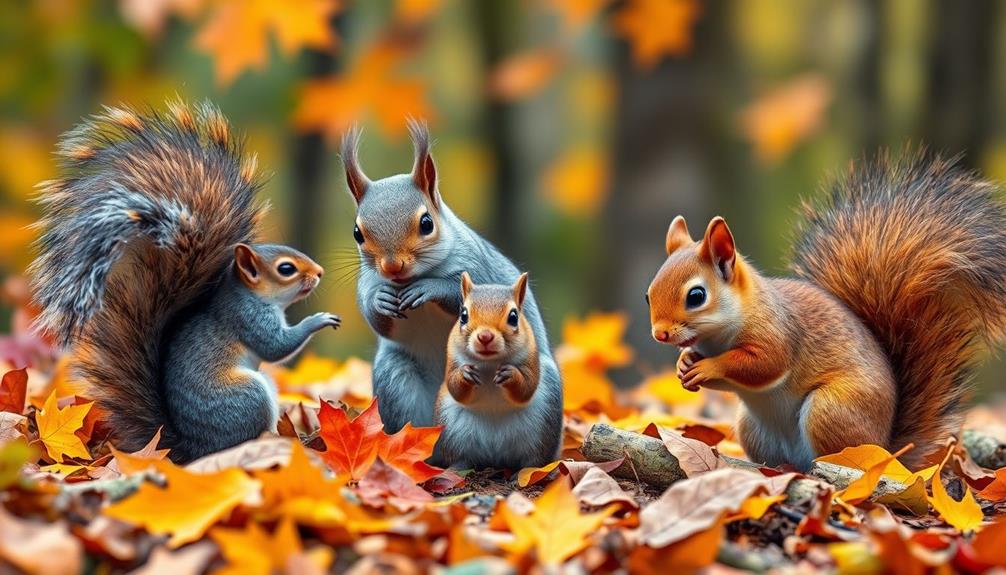
When you're identifying squirrel lookalikes, keep an eye out for flying squirrels, gophers, and dormice. Flying squirrels glide through trees and are nocturnal, while gophers thrive underground and are solitary creatures. Dormice, on the other hand, share physical traits with squirrels but are generally smaller and have different habitats. Nutria and muskrats also resemble squirrels at first glance, yet they prefer wetland environments. Each species has unique diets and adaptations, helping them play crucial roles in their ecosystems. If you want to uncover more about these intriguing similarities and differences, there's plenty more to explore.
Key Takeaways
- Ground squirrels have extensive tunnel systems and are social, contrasting with solitary gophers that prefer underground living.
- Flying squirrels possess gliding adaptations and thrive in low-light conditions, differing from sugar gliders which form strong colony bonds.
- Nutria are larger, with distinctive orange incisors, while muskrats are smaller with flattened tails and partially webbed feet.
- Gundis inhabit rocky areas and have a fluffy appearance, while dormice are smaller and have varied habitats across continents.
- Bushy-Tailed Woodrats are larger than Eastern Chipmunks and have omnivorous diets, while chipmunks primarily consume seeds and nuts.
Overview of Squirrel-Like Animals
When you think of squirrel-like animals, it's easy to see how various species can be mistaken for squirrels due to their similar physical traits. Many people confuse ground squirrels with other small rodents like gophers, even though ground squirrels form extensive tunnel systems and exhibit different social structures.
These distinctions highlight the significance of play in enhancing sensory and cognitive growth in children as they explore their surroundings, much like how different species adapt to their environments the significance of play.
Flying squirrels also add to the mix, possessing gliding adaptations that allow them to navigate through trees, yet they belong to a separate family and have distinct diets and habitats.
You might also encounter gundi and dormice, small rodents with body structures and fur resembling that of squirrels. However, their behaviors and living environments set them apart. It's vital to recognize these differences.
While all these animals share some physical attributes with squirrels, they each play unique roles in their ecosystems.
Understanding the diversity among squirrel species not only helps in proper identification but also emphasizes the significance of conservation efforts for endangered species like the Giant Bushy-Tailed Cloud Rat.
Nutria and Muskrat Comparison
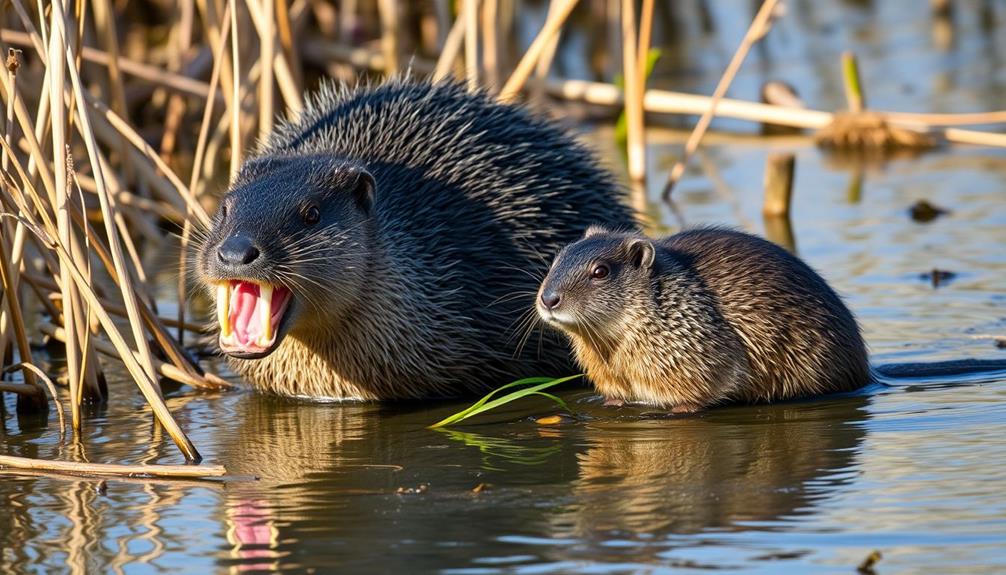
When comparing nutria and muskrats, you'll notice distinct differences in habitat preferences, dietary habits, and physical characteristics.
Nutria thrive in wetland areas and are known for their group living, while muskrats prefer solitude or small family units.
Curiously, understanding the dietary needs of these animals can parallel insights on dog nutrition as both require specific diets to thrive.
As you explore their eating habits and appearances, these contrasts become even clearer.
Habitat Preferences
Nutria and muskrats thrive in distinctly different habitats, each adapted to their unique lifestyles. Nutria, also known as coypus, prefer wetland habitats like marshes and riverbanks, where abundant vegetation supports their needs. Their preference for such environments resembles the cultural significance seen in ancient Hopi villages, showcasing how species adapt to their surroundings.
You'll find nutria primarily in regions with warm climates, reflecting their South American origins. In contrast, muskrats are native to North America and can adapt to a variety of climates, even colder ones. They typically inhabit areas near lakes, ponds, and slow-moving streams.
Both species build homes suited to their environments. Nutria create burrows near water edges, while muskrats construct lodges or burrows in banks, using reeds and grasses for shelter.
When observing these species, you might notice that nutria are more robust, with a distinctive long, round tail. Muskrats are smaller, featuring a flattened tail that aids in swimming.
Understanding their habitat preferences is essential for identifying these animals. While they may share some similarities with squirrels in appearance, these two species have evolved distinctly to thrive in their respective environments, showcasing the diversity of wildlife in North America.
Dietary Habits
Both nutria and muskrats play important roles in their ecosystems, which is evident in their dietary habits. While both are primarily herbivorous, their diets reflect some differences that are essential to their survival and influence on the environment.
Nutria are known to consume a wide variety of aquatic vegetation, which can lead to issues like overgrazing, affecting local flora. This behavior is somewhat similar to the debate surrounding meat consumption and its impact on ecosystems, as both can have significant effects on their surroundings.
Here's a quick comparison of their dietary habits:
- Nutria: Primarily feed on aquatic vegetation, roots, and grasses, consuming up to 25% of their body weight daily.
- Muskrats: Also focus on aquatic plants but occasionally eat small invertebrates and fish, showcasing a more varied diet.
- Seasonal Changes: Both species adapt their diets based on availability—nutria switch to whatever vegetation is abundant, while muskrats rely on stored food in winter.
- Ecosystem Impact: Nutria can overgraze, affecting local flora, while muskrats contribute positively by creating burrows that maintain healthy aquatic plant communities.
Just like the red squirrels, Eastern Gray, and Eastern chipmunks, nutria and muskrats are part of a larger ecosystem involving multiple species.
Understanding their dietary habits helps you appreciate their roles in maintaining balance within their habitats.
Physical Characteristics
Often mistaken for one another, nutria and muskrats exhibit distinct physical characteristics that can help you tell them apart. Nutria, or coypus, have a robust body, webbed feet, and a long, round tail. In contrast, muskrats boast a more elongated body, partially webbed hind feet, and a long, flattened tail covered in fur.
Understanding the emotional turmoil experienced by children of BPD mothers can foster empathy in recognizing the challenges faced by both species in their environments.
When it comes to fur coloration, both species typically showcase shades of brown, but nutria often display variations in color, with a lighter, reddish hue on their underparts. Muskrats, on the other hand, tend to have a darker, more uniform grayish-brown fur.
You'll also notice distinctive characteristics in their teeth. Nutria have large, orange incisors, while muskrats possess smaller, less prominent teeth. Size is another factor; adult muskrats usually weigh between 2 to 4 pounds, whereas nutria can weigh anywhere from 10 to 20 pounds.
Pay attention to their habitats, too. Nutria are primarily found in wetlands, known for their destructive feeding habits, while muskrats inhabit marshes and ponds, building their characteristic dome-shaped lodges.
These details make it easier to identify these two similar species.
Gundi and Dormice Features

Gundis and dormice share several striking features that make them resemble squirrels at first glance. While they belong to different families, their physical traits can often confuse casual observers. Here are some key similarities:
- Fluffy Tails: Both gundis and dormice have furry tails, contributing to their cute appearance.
- Body Structure: Gundis, also known as comb rats, have a body shape similar to squirrels, albeit with some differences in size. Curiously, just like many animals, gundis and dormice can form emotional connections with their surroundings, similar to how cats display affection towards their owners emotional attachment in cats.
- Diet: Like squirrels, gundis and dormice are adaptable feeders, enjoying fruits, flowers, nuts, and insects.
- Hibernation: Dormice are unique in their hibernation behavior, which can last up to six months, unlike the year-round activity of gundis.
Gundis primarily inhabit rocky areas and grasslands in Africa, while dormice can be found across Africa, Europe, and Asia.
Interestingly, dormice tend to be smaller than most squirrels, aiding in their identification. Understanding these features can help you distinguish between these fascinating creatures and the more commonly known squirrels.
Gopher and Ground Squirrel Traits
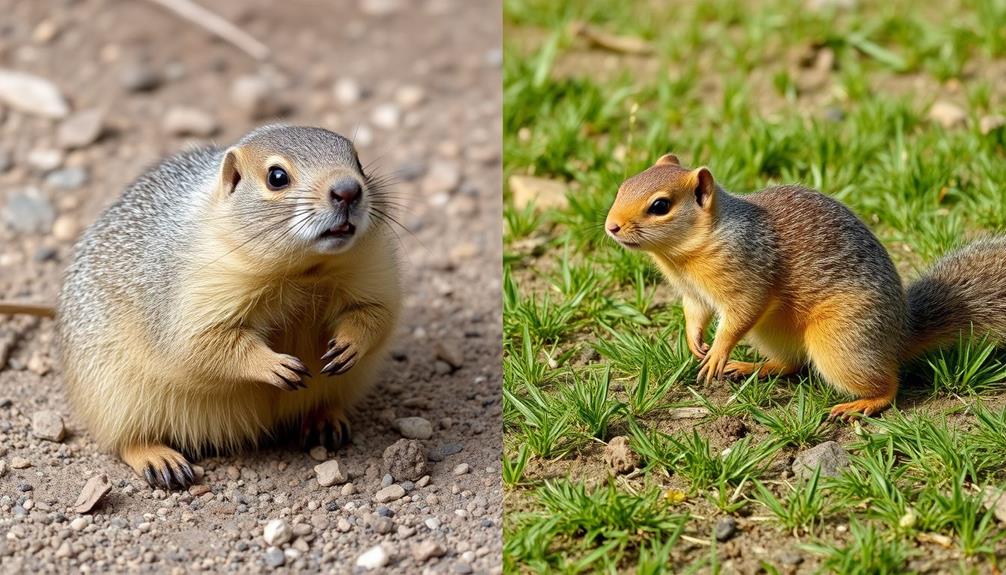
When you compare gophers and ground squirrels, you'll notice some key physical differences.
Gophers are stocky with large front teeth for digging, while ground squirrels have a more slender build and bushy tails.
Their habitat preferences also set them apart, as gophers mostly burrow underground, whereas ground squirrels are often seen foraging above ground in social groups.
Additionally, understanding the significance of auditory discrimination can enhance your observation skills when identifying these species in their natural environments, as improved sound recognition aids in distinguishing their behaviors and calls, which are essential for effective wildlife observation and research auditory processing benefits.
Physical Characteristics Comparison
If you take a closer look at gophers and ground squirrels, you'll notice some distinct differences in their physical characteristics. For those who enjoy gardening, understanding local wildlife can be essential, especially when considering unique indoor planters that might attract these critters.
Here are four key traits to help you identify them:
- Body Shape: Gophers have stocky bodies, while ground squirrels are more slender.
- Tail Type: Gophers possess short tails, whereas ground squirrels sport longer, bushy tails that help with balance when climbing.
- Teeth Structure: Gophers have large, continuously growing incisors for digging, while ground squirrels have smaller teeth suited for their herbivorous diet.
- Fur Patterns: Gophers usually showcase a uniform brown or gray color, while ground squirrels often display a mix of grays, browns, and tans with distinctive markings or stripes.
Though gophers and ground squirrels are closely related, these physical characteristics set them apart.
Remember, while squirrels are much more social and can be seen foraging in the sun, gophers prefer their underground burrows year-round.
Habitat Preferences Distinctions
Understanding the physical characteristics of gophers and ground squirrels provides a solid foundation for exploring their habitat preferences. Gophers thrive in underground burrows, primarily in loose, sandy soil. This subterranean lifestyle allows them to avoid predators while feeding on plant roots, which can lead to significant crop damage.
In contrast, ground squirrels create extensive tunnel systems in various habitats, including grasslands and forests. Their burrows are simpler and often used for nesting and food storage. Additionally, just like how modern technology enhances home security for homeowners, these species have adapted their burrowing behaviors to optimize their chances of survival in their respective environments.
When it comes to social behavior, ground squirrels are more communal, often living in colonies and exhibiting group behaviors. Gophers, however, are generally solitary creatures and prefer to maintain their own territory. This distinction in social structure influences their habitat choices, with ground squirrels favoring areas that support larger populations.
Additionally, the complexity of gopher burrows, featuring multiple entrances and chambers, highlights their adaptation to a solitary, underground existence. Meanwhile, ground squirrels' bushy tails and slender bodies aid in their agility on the surface, allowing them to navigate a diverse range of habitats more effectively.
Knowing these distinctions helps you appreciate the unique ecological roles both species play.
Bushy-Tailed Woodrat and Chipmunk

In the vibrant ecosystems of North America, the Bushy-Tailed Woodrat and the Eastern Chipmunk often draw attention due to their striking similarities.
While they may look alike, understanding their differences can enhance your appreciation for these fascinating creatures. For instance, acclimatization to their environments can play a significant role in their survival, much like how altitude acclimatization can enhance fat burning during a climb weight loss guide.
Here are some key distinctions:
- Size: Eastern Chipmunks are smaller, averaging 8-10 inches, while Bushy-Tailed Woodrats range from 12-16 inches.
- Activity Patterns: Chipmunks are diurnal, so you'll see them active during the day. In contrast, Bushy-Tailed Woodrats are nocturnal, foraging at night.
- Habitat: Eastern Chipmunks thrive in forested areas and suburbs, whereas Bushy-Tailed Woodrats prefer rocky habitats, mainly found in the western United States.
- Diet: The diet of Eastern Chipmunks mainly consists of seeds, nuts, and fruits, while Bushy-Tailed Woodrats are omnivorous, enjoying a variety of plant materials and occasionally insects.
Flying Squirrels and Sugar Gliders

When you spot a flying squirrel or a sugar glider, it's easy to be captivated by their remarkable adaptations for life in the trees. Both species are nocturnal, allowing them to thrive in low-light conditions. Their large eyes enhance their night vision, making it easier for them to navigate through the dark forest canopy.
Flying squirrels, found in North America and Asia, possess a unique patagium that enables them to glide distances of up to 150 feet between trees. Sugar gliders, native to Australia, share this trait, effortlessly soaring through their forest homes.
While flying squirrels primarily feed on a diet of fruits, nuts, and tree bark, sugar gliders enjoy a more varied diet that includes nectar, fruits, and insects. This difference reflects their distinct ecological niches.
Social structures also vary; flying squirrels often live in family groups, while sugar gliders are highly social, forming colonies and developing strong bonds with one another.
Understanding these differences can help you appreciate the unique lifestyles of these fascinating creatures as they glide gracefully through the trees.
Conservation and Education Importance

Squirrel lookalikes, like the Giant Bushy-Tailed Cloud Rat and the Anomalure, face serious threats from habitat loss and hunting, making conservation efforts crucial. By understanding these species better, you can help promote their protection.
Here are some ways you can get involved:
- Participate in wildlife identification workshops to learn about squirrel lookalikes and their unique traits.
- Engage in citizen science projects that monitor local populations of these animals, fostering community responsibility.
- Support awareness campaigns that highlight the importance of habitat preservation for these species and their ecosystems.
- Share your knowledge with friends and family to enhance public understanding of biodiversity and the roles these animals play.
Accurate wildlife education can greatly reduce misidentification issues, leading to more effective conservation actions.
By actively participating in these initiatives, you contribute to the broader conservation efforts needed for squirrel lookalikes and their habitats. Together, we can promote a healthier ecosystem and guarantee that these fascinating creatures continue to thrive in their natural environments.
Your efforts in wildlife identification and habitat preservation make a difference!
Frequently Asked Questions
What Looks Like a Squirrel but Isn't a Squirrel?
You might see animals like nutria, muskrats, or even gundi that resemble squirrels. Look for webbed feet, flattened tails, or stripes to tell them apart. Always pay attention to their habitat and behavior, too!
What Animal Resembles a Squirrel?
When you explore nature, you'll notice animals like nutria with their semi-aquatic lifestyle, muskrats along riverbanks, or chipmunks with their stripes. Each shares a resemblance to squirrels, yet they each belong to different worlds.
What Looks Similar to a Squirrel?
When you observe animals in nature, you might notice creatures like nutria or muskrats that share similar sizes and bushy tails with squirrels. Their habitats and behaviors, however, reveal significant differences that distinguish them.
What Animal Looks Like an Overgrown Squirrel?
If you're wondering what looks like an overgrown squirrel, you might consider the Nutria or the Laotian Rock Rat. Both have similar body shapes and bushy tails, yet they live in different environments.
Conclusion
In the forest of life, every creature plays its part, often cloaked in similar looks but unique stories. Just as you might mistake a chipmunk for a woodrat, remember that beneath each surface lies a rich tapestry of traits and behaviors. Embrace the diversity around you; it mirrors our own differences. By understanding these squirrel lookalikes, you nurture both nature and knowledge, forging connections that spark curiosity and inspire conservation in your own backyard.
Dana is our Lead Content Writer, bringing a wealth of knowledge and expertise to our team. With a background deeply rooted in animal studies and a profound love for all creatures, Dana is dedicated to crafting engaging and informative content that resonates with our audience. With Dana at the helm, you can trust that our content is accurate and engaging, catering to the diverse interests of animal enthusiasts everywhere.
-

 Vetted2 months ago
Vetted2 months ago15 Best Dog Food Brands Recommended by Vets for Healthy and Happy Pups
-

 Vetted2 months ago
Vetted2 months ago14 Best Homemade Dog Food Recipes Your Pup Will Love – Vet Approved & Nutritious
-

 Vetted2 months ago
Vetted2 months ago15 Best Cat Foods for Managing Hyperthyroidism – Vet Approved and Feline Friendly
-

 Vetted2 months ago
Vetted2 months ago15 Best Affordable Dog Foods That Won't Break the Bank
-

 Vetted2 months ago
Vetted2 months ago15 Best Dog Foods for Kidney Disease – Expert Recommendations for Your Pet's Health
-

 Vetted2 months ago
Vetted2 months ago15 Best Affordable Cat Foods That Won't Break the Bank
-
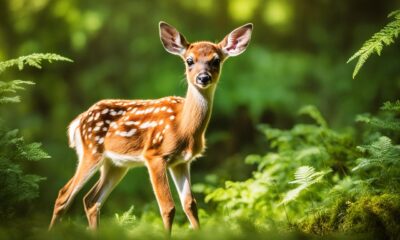
 Deers3 months ago
Deers3 months agoCaring for Baby Deer: Tips for Healthy Fawns
-

 Cats1 month ago
Cats1 month agoCat Weight Chart by Age: Kitten to Senior in Lbs


















